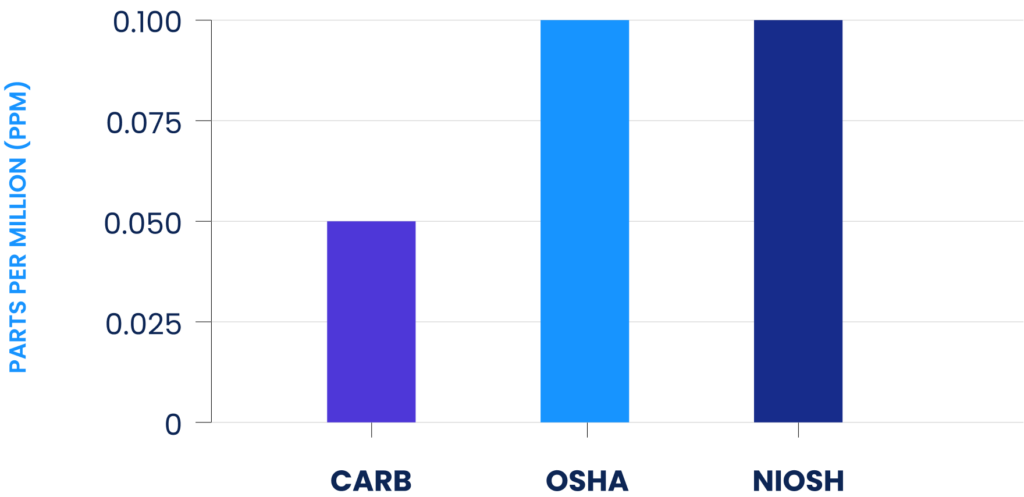
Debunking the myths about Ozone and UV-C
It’s natural to be concerned about the impact of ozone on human health and ask if a particular technology creates risk. But to make the right choice, it’s important to distinguish facts from fears.
Below, we explain ozone production in various products, the link between Far-UV light and ozone, and how California’s stringent standards protect anyone using a certified device.
Ozone Production in Various Products
First, it’s important to understand that ozone is a molecule composed of three oxygen atoms, often formed as a by-product of certain electronic appliances and industrial processes. Some air purifiers, for instance, deliberately produce ozone because of its ability to oxidize and eliminate airborne contaminants. However, the amount produced varies significantly among different types of products.
- Ionic air purifiers produce ozone as a by-product of ionizing air particles to remove pollutants. The levels can vary depending on the model and settings.
- Ozone generators, as the name suggests, are designed to produce ozone deliberately and can create high concentrations, especially those used for industrial purposes.
- Other electronic devices and appliances, depending on their design and function, might produce trace amounts of ozone, usually insignificant from a health perspective.
It’s worth noting that the EPA concludes that, “Available scientific evidence shows that at concentrations that do not exceed public health standards, ozone has little potential to remove indoor air contaminants.”
Ozone regulation
Various government agencies have established indoor ozone standards. As shown below, the California Air Resources Board (CARB) standard is twice as strict as Federal Occupational Safety and Health Administration (OSHA) and the National Institute of Occupational Safety and Health (NIOSH).
Allowable ozone output by different regulators

UV-C Light and Ozone Production
UV-C light has been gaining attention for its potential to inactivate microbes. One concern that arises is its interaction with oxygen molecules, potentially leading to ozone formation.
The best way to alleviate that concern is to look for CARB-certified devices that, if they produce any ozone at all, do it at a minimal, safe level that’s essentially consistent with the ozone level already present in the air.
CARB Certification and Its Process
As mentioned above, CARB has set the strictest standard in the nation for indoor ozone, and it certifies electronic appliances with rigorous testing and evaluation to ensure they meet stringent air-quality standards. Here is the list of CARB-certified air cleaning devices.
R-Zero UV-C devices are all below the strictest limits for ozone production
R-Zero’s Beam, Vive, and Arc are all CARB-certified, and also tested and certified to UL ozone standards 867, the standard for electrostatic air cleaning (<50ppm).
The same UV-C light that powers R-Zero’s Eon was tested for ozone production and found to add less than 6 parts per billion to the ambient ozone level. Additionally, Eon is UL 2998 certified, which validates “zero ozone production” and requires under 50 parts per billion.
More posts you might like
-

The evolution of workplace experience and design: 4 trends shaping the future of office spaces in 2024
As workplace standards evolve, office design must adapt to new expectations around hybrid work and sustainability. JLL’s recent U.S. and Canada Design Trends and Cost Guide highlights key shifts shaping the future of office spaces. Workplace experience trend 1: Human-led design Workspaces are being reimagined to support both collaborative and focused work. The emphasis is […]
-

Embracing the Future of Buildings with BOMA’s 2024 Office Standard
The Building Owners and Managers Association (BOMA) Office Standard is a strategic tool that empowers property managers, owners, and tenants to navigate the complexities of the commercial real estate market. Used to compute the floor area in and around office buildings and updated to reflect the changing needs of the CRE market, the BOMA Office […]
-

The Importance of Improving Indoor Air Quality in Senior Care Facilities
With the increasing number of wildfires happening across North America every year, providing optimal indoor air quality in senior living facilities has never been more essential. Last year, wildfire smoke affected 120 million people in Canada and the United States, triggering air quality alerts across these regions. Seniors are particularly vulnerable to poor air quality […]